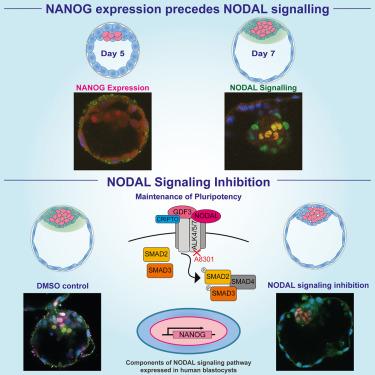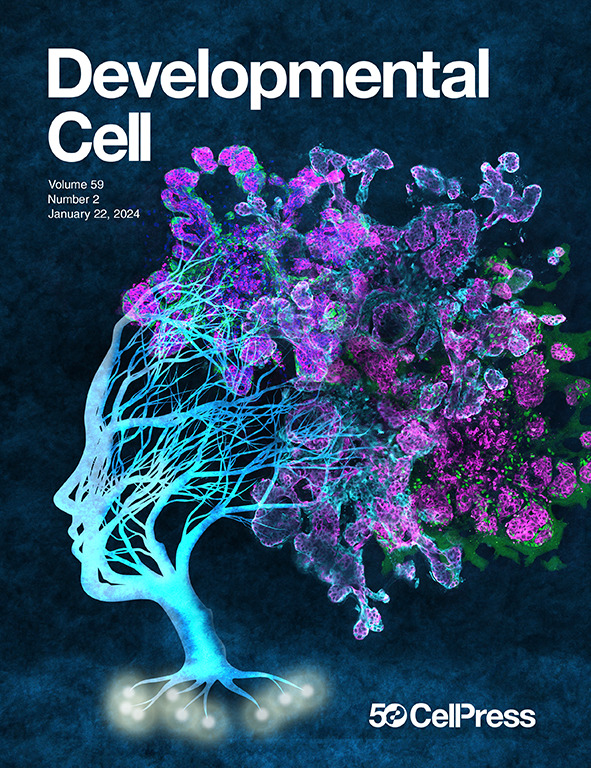植入前人类发育过程中多能上胚层的启动和维持与 NODAL 信号无关
IF 10.7
1区 生物学
Q1 CELL BIOLOGY
引用次数: 0
摘要
人类胚泡含有多能上胚层,人类胚胎干细胞(hESCs)可从上胚层中获得。ACTIVIN/NODAL信号维持转录因子NANOG的表达和hESCs的体外繁殖。目前还不清楚这是否反映了人类胚胎上胚层发育的功能要求。在这里,我们描述了人类胚胎植入前发育过程中 NODAL 信号活动的特征。我们发现,NANOG 是限制在新生人类多能上胚层的早期分子标记,并且在 NODAL 信号开始之前就已经启动。我们进一步证明,在没有 NODAL 信号活动的情况下,多能性相关转录因子 NANOG、SOX2、OCT4 和 KLF17 的表达在上胚层中得以维持。全基因组转录分析表明,NODAL 信号抑制不会降低 NANOG 的转录,也不会影响更广泛的多能性相关基因调控网络。这些数据表明,与现有的 hESC 培养相比,植入前人类上胚层中调节多能性的信号要求有所不同。本文章由计算机程序翻译,如有差异,请以英文原文为准。

Initiation and maintenance of the pluripotent epiblast in pre-implantation human development is independent of NODAL signaling
The human blastocyst contains the pluripotent epiblast from which human embryonic stem cells (hESCs) can be derived. ACTIVIN/NODAL signaling maintains expression of the transcription factor NANOG and in vitro propagation of hESCs. It is unknown whether this reflects a functional requirement for epiblast development in human embryos. Here, we characterized NODAL signaling activity during pre-implantation human development. We showed that NANOG is an early molecular marker restricted to the nascent human pluripotent epiblast and was initiated prior to the onset of NODAL signaling. We further demonstrated that expression of pluripotency-associated transcription factors NANOG, SOX2, OCT4, and KLF17 were maintained in the epiblast in the absence of NODAL signaling activity. Genome-wide transcriptional analysis showed that NODAL signaling inhibition did not decrease NANOG transcription or impact the wider pluripotency-associated gene regulatory network. These data suggest differences in the signaling requirements regulating pluripotency in the pre-implantation human epiblast compared with existing hESC culture.
求助全文
通过发布文献求助,成功后即可免费获取论文全文。
去求助
来源期刊

Developmental cell
生物-发育生物学
CiteScore
18.90
自引率
1.70%
发文量
203
审稿时长
3-6 weeks
期刊介绍:
Developmental Cell, established in 2001, is a comprehensive journal that explores a wide range of topics in cell and developmental biology. Our publication encompasses work across various disciplines within biology, with a particular emphasis on investigating the intersections between cell biology, developmental biology, and other related fields. Our primary objective is to present research conducted through a cell biological perspective, addressing the essential mechanisms governing cell function, cellular interactions, and responses to the environment. Moreover, we focus on understanding the collective behavior of cells, culminating in the formation of tissues, organs, and whole organisms, while also investigating the consequences of any malfunctions in these intricate processes.
 求助内容:
求助内容: 应助结果提醒方式:
应助结果提醒方式:


